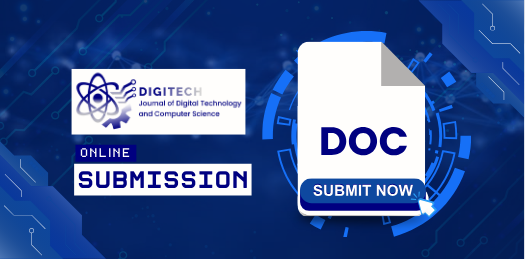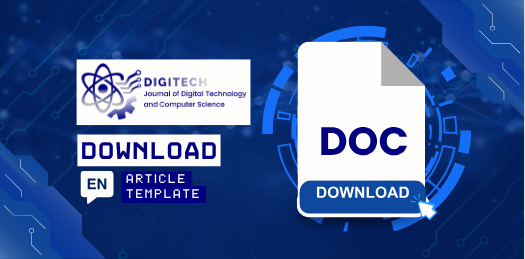Classify: Classroom Reservation Mobile Application for Students Based on Agile Development
DOI:
https://doi.org/10.61220/digitech.v3i1.20252Keywords:
Agile Method, Android , Classroom reservation, Mobile ApplicationAbstract
Classroom management in higher education often suffers from inefficiencies and scheduling conflicts as the reservation process is still carried out manually. To address these issues, this research developed Classify, an Android-based mobile application designed to help students reserve classrooms in a structured, efficient and digital way. The development followed the agile method using the Scrum framework, which was divided into three iterative sprints, including system planning, interface design with Figma, backend integration through Firebase and implementation of the main functions such as login, class list per floor, booking system and user profile management. System modeling is done with the Unified Modeling Language (UML), including Use Case Diagram and Activity Diagram. The tests are carried out using black-box and white-box methods to ensure the reliability of the system and the correctness of the program logic. The test results show that all functions work as expected and meet user requirements. Classify is thus able to improve the efficiency of the classroom reservation process, reduce the administrative burden and contribute to the digitalization of academic services in higher education.
References
[1] R. Anggraeni dan I. E. Maulani, “Pengaruh Teknologi Informasi Terhadap Perkembangan Bisnis Modern,” Jurnal Sosial Teknologi, vol. 3, no. 2, hlm. 94–98, Feb 2023, doi: 10.59188/jurnalsostech.v3i2.635.
[2] Y. S. Mulyani, “E-Commerce Solusi Pemasaran UMKM Dalam Mengembangkan Industri Pariwisata Di Tengah Pademi Covid-19 (Studi Kasus UMKM di Kota Tasikmalaya),” Khasanah Ilmu - Jurnal Pariwisata Dan Budaya, vol. 12, no. 2, Art. no. 2, Sep 2021, doi: 10.31294/khi.v12i2.11293.
[3] D. Riswan, H. E. R. Putra, dan R. N. Saputra, “Pengembangan Sistem Rekomendasi Berbasis Kecerdasan Buatan Untuk Meningkatkan Pengalaman Pengguna Di Platform E-Commerce,” Jurnal Komputer Teknologi Informasi dan Sistem Informasi (JUKTISI), vol. 2, no. 3, Art. no. 3, Feb 2024, doi: 10.62712/juktisi.v2i3.145.
[4] A. Adenowo dan B. Adenowo, “Software Engineering Methodologies: A Review of the Waterfall Model and Object- Oriented Approach,” International Journal of Scientific and Engineering Research, vol. 4, hlm. 427–434, Sep 2020.
[5] S. Yulina, S. P. Arifin, dan Y. D. L. Widyasari, “PELATIHAN PENGEMBANGAN KOMPETENSI SISWA DALAM MERANCANG UI/UX MENGGUNAKAN FIGMA PADA SMK MUHAMMADIYAH 2 PEKANBARU,” Jurnal Pengabdian Masyarakat Multidisiplin, vol. 8, no. 1, Art. no. 1, Okt 2024, doi: 10.36341/jpm.v8i1.4982.
[6] C. Ningki dan N. P, “Implementasi Aplikasi Penjualan Produk Tradisional Berbasis Website Menggunakan Metode Waterfall,” Informatik : Jurnal Ilmu Komputer, vol. 19, no. 2, Art. no. 2, Sep 2023, doi: 10.52958/iftk.v19i2.6149.
[7] R. Risald, “IMPLEMENTASI SISTEM PENJUALAN ONLINE BERBASIS E-COMMERCE PADA USAHA UKM IKE SUTI MENGGUNAKAN METODE WATERFALL,” Journal of Information and Technology, vol. 1, hlm. 37–42, Agu 2021, doi: 10.32938/jitu.v1i1.1393.
[8] M. Hendriawan, T. Budiman, V. Yasin, dan A. S. Rini, “PENGEMBANGAN APLIKASI E-COMMERCE DI PT. PUTRA SUMBER ABADI MENGGUNAKAN FLUTTER,” Journal of Information System, Informatics and Computing, vol. 5, no. 1, Art. no. 1, Jun 2021, doi: 10.52362/jisicom.v5i1.371.
[9] S. Aisyah, R. Amelia, I. Sabrina, dan T. Syahrifah, “PERANCANGAN APLIKASI E-COMMERCE PADA TOKO LILI DENGAN PENERAPAN METODE WATERFALL,” Jurnal Sistem Informasi dan Ilmu Komputer, vol. 5, no. 1, Art. no. 1, Agu 2021, doi: 10.34012/jurnalsisteminformasidanilmukomputer.v5i1.1917.
[10] T. Haryati, D. H. Kusuma, dan H. Ferliyanti, “Penerapan Metode Waterfall Sebagai Pengembangan Perangkat Lunak Sistem Informasi Penjualan PT. Arta Putra Nugraha Karawang,” Simpatik: Jurnal Sistem Informasi dan Informatika, vol. 1, no. 2, Art. no. 2, Des 2021, doi: 10.31294/simpatik.v1i2.955.
[11] R. A. Ghani, N. W. Azani, S. N. Auliani, S. Maharani, M. D. Gustinov, dan M. L. Hamzah, “Perancangan Sistem Informasi e- Commerce Berbasis Website Menggunakan Metode Waterfall,” Prosiding Seminar Nasional Teknologi Informasi dan Bisnis, hlm. 99–106, Jul 2022.
[12] A. Hidayat, F. Faisal, K. P. Harum, dan M. M. Fakhri, “Sistem Informasi Permintaan Barang Atk (Alat Tulis Kantor) Pada Pengadilan Negeri Makassar Kelas Ia Khusus,” Jurnal Media Elektrik, vol. 20, no. 2, hlm. 77–85, 2023.
[13] B. Yuanita, M. M. Fakhri, dan W. Hidayat, “Sistem Informasi Medical Record Pasien Pada Puskesmas Sudu Kec. Alla Kab. Enrekang Berbasis Website,” Journal of Embedded Systems, Security and Intelligent Systems, hlm. 93–100, 2021.
[14] Fariz Rahmat Mulyadi dan Yuda Syahidin, “Rancang Bangun Sistem Informasi Kepegawaian dengan Metode Waterfall,” Explore: Jurnal Sistem Informasi dan Telematika, vol. 12, no. 2, hlm. 186–196, Des 2021, doi: 10.36448/jsit.v12i2.2056.
[15] “A Wearable Sonification System to Improve Movement Awareness: A Feasibility Study.” Diakses: 24 April 2025. [Daring]. Tersedia pada: https://www.mdpi.com/2076-3417/14/2/816
[16] M. Prihandoyo, “Unified Modeling Language (UML) Model Untuk Pengembangan Sistem Informasi Akademik Berbasis Web,” Jurnal Informatika: Jurnal Pengembangan IT, vol. 3, hlm. 126–129, Jan 2018, doi: 10.30591/jpit.v3i1.765.
[17] S. Syauqi dan S. Suendri, “Information System Design of Web-Based Document Archives Management In The Office Bappeda of North Sumatra Province,” Journal of Information Systems and Technology Research, vol. 1, no. 1, Art. no. 1, Jan 2022, doi: 10.55537/jistr.v1i1.66.
[18] M. M. Fakhri, M. S. J. Irmawan, A. S. Alwi, I. F. Asril, N. Q. Ridhaihi, dan D. Fadhilatunisa, “Perancangan Sistem Informasi Manajemen Karyawan Berbasis Website dengan Metode Waterfall,” Jurnal Mediatik, hlm. 35–44, 2023.
[19] Z. A. Hamza dan M. Hammad, “Analyzing UML use cases to generate test sequences,” Jan 2021, Diakses: 24 April 2025. [Daring]. Tersedia pada: https://journal.uob.edu.bh:443/handle/123456789/3923
[20] R. Fauzan, D. Siahaan, S. Rochimah, dan E. Triandini, “Automated Class Diagram Assessment using Semantic and Structural Similarities,” International Journal of Intelligent Engineering and Systems, vol. 14, no. 2, hlm. 52–66, 2021, doi: 10.22266/ijies2021.0430.06.
[21] M. R. Wayahdi dan F. Ruziq, “Pemodelan Sistem Penerimaan Anggota Baru dengan Unified Modeling Language (UML) (Studi Kasus: Programmer Association of Battuta),” Jurnal Minfo Polgan, vol. 12, no. 1, Art. no. 1, Agu 2023, doi: 10.33395/jmp.v12i1.12870.
[22] Y. S. Purbo, F. S. Utomo, dan Y. Purwati, “Analisis dan Perancangan Antarmuka Aplikasi Wisata Menggunakan Metode User Centered Design (UCD),” Jurnal Teknologi Terpadu, vol. 9, no. 2, Art. no. 2, Des 2023, doi: 10.54914/jtt.v9i2.977.
[23] M. Muauwanah, H. D. Saputra, M. Afifudin, dan M. Y. P. Chusnani, “Implementasi Pengujian Black Box pada Form Login E-Learning di Universitas Airlangga,” Jurnal Sistem Informasi, Manajemen dan Teknologi Informasi, vol. 2, no. 2, Art. no. 2, Jul 2024, doi: 10.33020/jsimtek.v2i2.727.
[24] “Keamanan Sebuah Sistem Point of Sale: Sampai Sejauh Mana?” Diakses: 24 April 2025. [Daring]. Tersedia pada: https://www.opaper.app/blog/keamanan-point-of-sale
[25] C. A. Pamungkas dan A. Lutfiyani, “Sistem Informasi Kasir pada Usaha Serba Rasa Food Program Wirausaha Merdeka IPB University Berbasis Website Menggunakan Metode Waterfall,” Jurnal Penelitian Inovatif, vol. 4, no. 2, Art. no. 2, Apr 2024, doi: 10.54082/jupin.314.
[26] Lesmono, I. D. (2018). RANCANG BANGUN SISTEM INFORMASI PENJUALAN SEPATU BERBASIS WEBSITE DENGAN METODE WATERFALL. Swabumi, 6(1). https://doi.org/10.31294/swabumi.v6i1.3316
Downloads
Published
Issue
Section
License
Copyright (c) 2025 Joy Febrianto Hale, Muhammad Taufiq Alhidayah Syah , Surya Radi Ramdhani. S (Author)

This work is licensed under a Creative Commons Attribution 4.0 International License.








 Email:
Email: 
